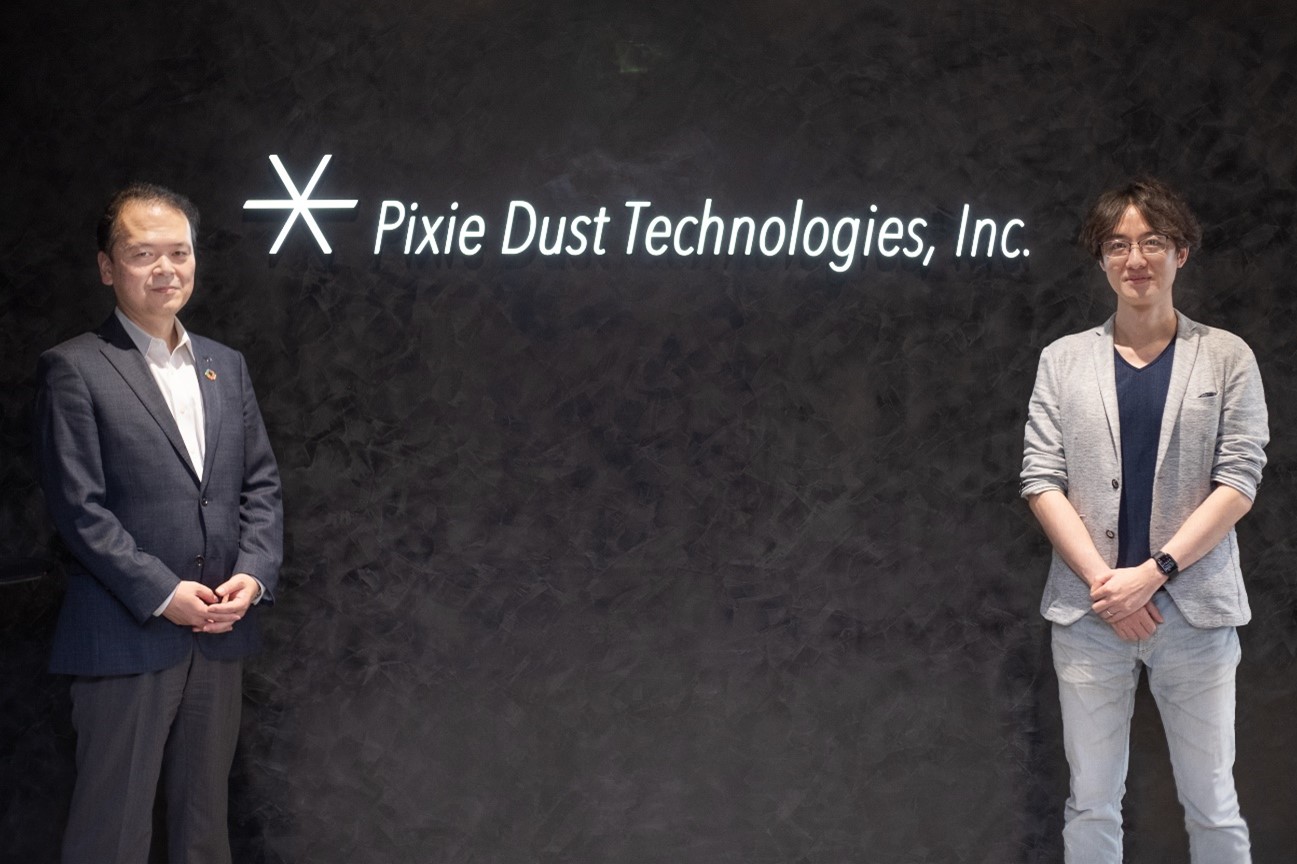
ピクシーダストテクノロジーズ株式会社(本社:千代田区、代表取締役:落合 陽一、村上 泰一郎、以下「PxDT」)と塩野義製薬株式会社(本社:大阪市中央区、代表取締役社長:手代木 功、以下「塩野義製薬」)は、「音刺激による脳活性化および認知機能改善」に向けた共同研究に関する基本合意書(以下、本合意書)を締結しましたので、お知らせいたします。
背景
国内において高齢者人口は増加し続けており、28.4%と世界で最も高い高齢化率となっております¹。日本の高齢者における認知症有病率は約15%と推計されており、高齢化の進展に伴って有病者数はさらに増加すると予想されております²。認知症は記憶・学習、言語能力、判断能力などの認知機能が障害されることでご本人のQOL(Quality of Life)が低下するとともに、介護者の肉体的、精神的、経済的負担にもつながり、社会に与える影響が大きい疾患です。一方で、既存治療法に対する患者満足度は高くなく³、新たなソリューションが求められています。
今回の取り組みについて
認知機能障害の特徴の一つとして、脳内で認知機能を発揮するのに必要な脳の特定のリズム活動(ガンマ波)が低下していることが報告されています⁴。
塩野義製薬とPxDTは2021年12月より「生活に溶け込んだ形で、自然に五感を刺激することによって長期的な介入を可能とし、認知症ケアを実現する」というコンセプトを掲げ、感覚刺激による脳のリズム活動の変化に着目した、新しいサービスの開発に向けた共同研究に取り組んできました。その中で、脳の特定のリズム活動(ガンマ波)を強める可能性のある「音」を共同開発しました。本合意書の締結を通じて、今後は、テレビの音や音楽を自然な形で加工して特定のリズムの脳活動を強めるなど、「音」を通じたサービスの開発に向けたさらなるエビデンスの構築を目指してまいります。
今後の展望
PxDTと塩野義製薬は両社の強みを活かし、聴覚や視覚など五感刺激による「生活に溶け込んだ認知症ケア」サービスの開発を通じて、患者さまや社会の抱える困り事の解決に向けた新たなソリューションの提供に取り組んでまいります。
また、PxDTは共同開発中の音⁵を用いた一般家庭向けのプロダクトの開発を目指します。
ピクシーダストテクノロジーズ株式会社について
PxDTは、Digitally Rebalanced——世界をデジタル技術の観点から俯瞰し、新たな均衡点へ導く原動力となることを目指す大学発ベンチャーです。デジタルと物理世界を繋ぐインターフェース技術を研究開発し、連続的に社会実装していくことで、その実現に寄与します。
URL:https://pixiedusttech.com/news/
塩野義製薬株式会社について
塩野義製薬は、取り組むべき重要課題(マテリアリティ)として「社会生産性向上」を特定しています。引き続き、アンメットメディカルニーズの高い認知機能障害に対する画期的な治療法を患者さまにお届けできるよう努力し、精神・神経系疾患を抱える患者さまとそのご家族のQOLや生産性の向上に貢献してまいります。
URL:https://www.shionogi.com/jp/ja/
参考
1.令和2年度版高齢社会白書
2.平成26年度厚生労働省科学研究費補助金特別研究事業「日本における認知症の高齢者人口の将来推計に関する研究」
3.令和2年度 国内基盤技術調査報告書「60 疾患に関する医療ニーズ調査(第6回)」分析編
4.Herrmann, C. S., & Demiralp, T. (2005). Human EEG gamma oscillations in neuropsychiatric disorders. Clinical neurophysiology, 116(12), 2719-2733.
5.想定した特定のリズム(ガンマ波)の脳活動を生じさせる可能性のある音
Conclusion of a basic agreement between Pixie Dust Technologies and Shionogi for joint research for improvement of cognitive function and brain activation by sound stimulation
~ With the vision of offering continual care for dementia patient in everyday life~
Shionogi & Co., Ltd. (Headquarters: Osaka, Japan; President and CEO: Isao Teshirogi, Ph.D.; hereafter "Shionogi") and Pixie Dust Technologies, Inc. (Head Office: Chiyoda-ku, Tokyo, Representative Director: Yoichi Ochiai, Taiichiro Murakami, hereinafter “PxDT”) announce their entry into a basic agreement (hereinafter, the “Agreement”) to pursue brain activation and improvement of cognitive function by sound stimulation, with the aim of providing continual pervasive care for dementia patient in everyday life by sensory stimulus, based on the output rof joint research conducted thereunder.
■Background
In Japan, the elderly population is continuing to increase, reaching 28.4% of the overall population, which is the highest fraction in the world (*1). The prevalence of dementia in Japan’s elderly is estimated to be around 15%, and it is expected to increase further (*2). Dementia lowers the patients’ QOLs (Quality of Life) by disturbing cognitive functions such as memory, learning, language, and reasoning ability, which also results in physical, mental, and economic burden for caregivers. Furthermore, satisfaction with current therapeutic approaches is low (*3), and a new solution is required.
■Our Initiatives
In cognitive function disorders, a certain rhythmic activity (gamma waves) necessary to fulfill the cognitive function of the brain is found to decrease (*4). Since December 2021, PxDT and Shionogi have been conducting joint research on ways to activate cerebral rhythmic activities through sensory stimulus, with the concept that long-term intervention by sensory stimulation in everyday life may ameliorate the progress of dementia. In this effort, we have jointly developed a sonic technology that may enhance cerebral gamma wave rhythmic activity. The conclusion of this Agreement will allow us to accumulate further evidence and to develop a practical approach into incorporate this sonic stimulation into daily life, for example, through processing of TV sound and music.
■Future Outlook
By leveraging our respective strengths, PxDT and Shionogi plan to develop products and services that support dementia care in everyday life through stimulating senses such as sight and hearing, aiming to offer new solutions for people with dementia and society at large.
PxDT will also endeavor to develop a home use consumer product utilizing the sound currently under joint development (*5) under the concept of “realizing the dementia care that enables the long-term intervention to the brain by stimulating five senses spontaneously in everyday life.
■About Pixie Dust Technologies, Inc.
We, Pixie Dust Technologies, Inc., headquartered in Tokyo, are a company that is strongly confident that we are most superior in digital ultrasonic wave control in the whole world, led by two founders who hold Ph.D.
We are a tech company to deliver a “new option” in order to cater to unmet needs throughout the world that can go beyond the traditional approaches using medicine, such as “caregiving for dementia by intervening five senses.” We have a core technology specializing in “wave control technology” that can manipulate not only ultrasonic wave but also light and so-called electromagnetic wave, and our main domain is to “improve QOL”, “supplement and enhance physical abilities, and “deal with aging”, with a focus on the development of non-contact / non-invasive device in the field of health care and diversity.
URL:https://pixiedusttech.com/news/
■About SHIONOGI & CO., LTD.
Shionogi has identified “improving social productivity” as a material issue (materiality) we should address. We will continue to strive to deliver innovative treatments for cognitive function disorders with high unmet medical needs and to thereby contribute to improving the quality of life and productivity of people suffering from mental / neurological disease and those who support them. URL:https://www.shionogi.com/global/en/
■References:
1. Annual Report on the Aging Society 2020
2. Report of Research Supported by HLSRG (Health and Labor Sciences Research Grant) “Research on Future Changes in the Elderly Population with Dementia in Japan”
3. Domestic Basic Technology Survey Report 2020 "Survey on Medical Needs for 60 Diseases (6th)" Analysis
4. McDermott, B. et al. Gamma Band Neural Stimulation in Humans and the Promise of a New Modality to Prevent and Treat Alzheimer’s Disease. Journal of Alzheimer’s Disease 65, 363–392 (2018)
5. The sound with the possibility to evoke a certain cerebral rhythmic activity (gamma wave)